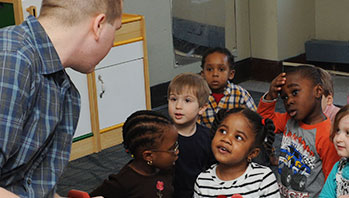- picture of your house
- pictures of houses and buildings of different sizes and shapes
- brick
- building
- home
- house
- material
MA Standards:
Speaking and Listening: SL.PK.MA.1a Observe and use appropriate ways of interacting in a group (e.g., taking turns in talking, listening to peers, waiting to speak until another person is finished talking, asking questions and waiting for an answer, gaining the floor in appropriate ways).
Reading for Informational Text: RI.P.MA.7 With prompting and support, describe important details from an illustration or photograph.
Head Start Outcomes:
Logic and Reasoning/Reasoning and Problem Solving Classifies, compares, and contrasts objects, events, and experiences.
Talk Together: Houses and Buildings

© Commonwealth of Massachusetts, Department of Early Education and Care (Jennifer Waddell photographer). All rights reserved.
STEM Key Concepts: Different materials are useful for making different structures and different parts of structures
ELA Focus Skills: Listening and Speaking, Vocabulary
Educator Prep: Display the pictures on a wall titled “Houses and Buildings.” Include drawings and photographs of structures children have constructed.
Introduce the new theme by directing children’s attention to the “Houses and Buildings” display. Tell children that they will be learning about different types of houses and buildings. Hold up a picture of your house and say, This is a picture of <my mom and dad’s> house. It is the home I grew up in. It is made of a material called brick.
- Call attention to the “Houses and Buildings” display as you continue to talk to children about houses as a type of building and homes as places where people live and feel like they belong.
- You may want to have children bring in a picture of the home where their family lives.
- Revisit the “Houses and Buildings” display throughout the week.
English Language Learners: Invite English language learners to introduce the words house and home to the group. Hold up pictures of houses that seem to be empty and tell children these buildings are types of houses. Have the group say, This is a house. Have the English language learner repeat the phrase in his or her first language. Then hold up pictures of families doing things together in their home (cooking, gardening, studying, etc.). Tell children these are pictures of families living in their home. Say, They are doing things inside their home. Have the group say, This is a family’s home.
Educator Tip: You may want to use this time to review ramps by describing something special about the picture of the house that you brought in, such as, Every year my dad climbs a ladder and ties a big flag across the front roof of the house to celebrate the Fourth of July. Then run your hand along the slant of the roof and ask,
- What do you notice about the roof? (it is slanted, a ramp, an inclined plane)
- What do you notice about other parts of the house? How is the house the same or different from the building you live in?
